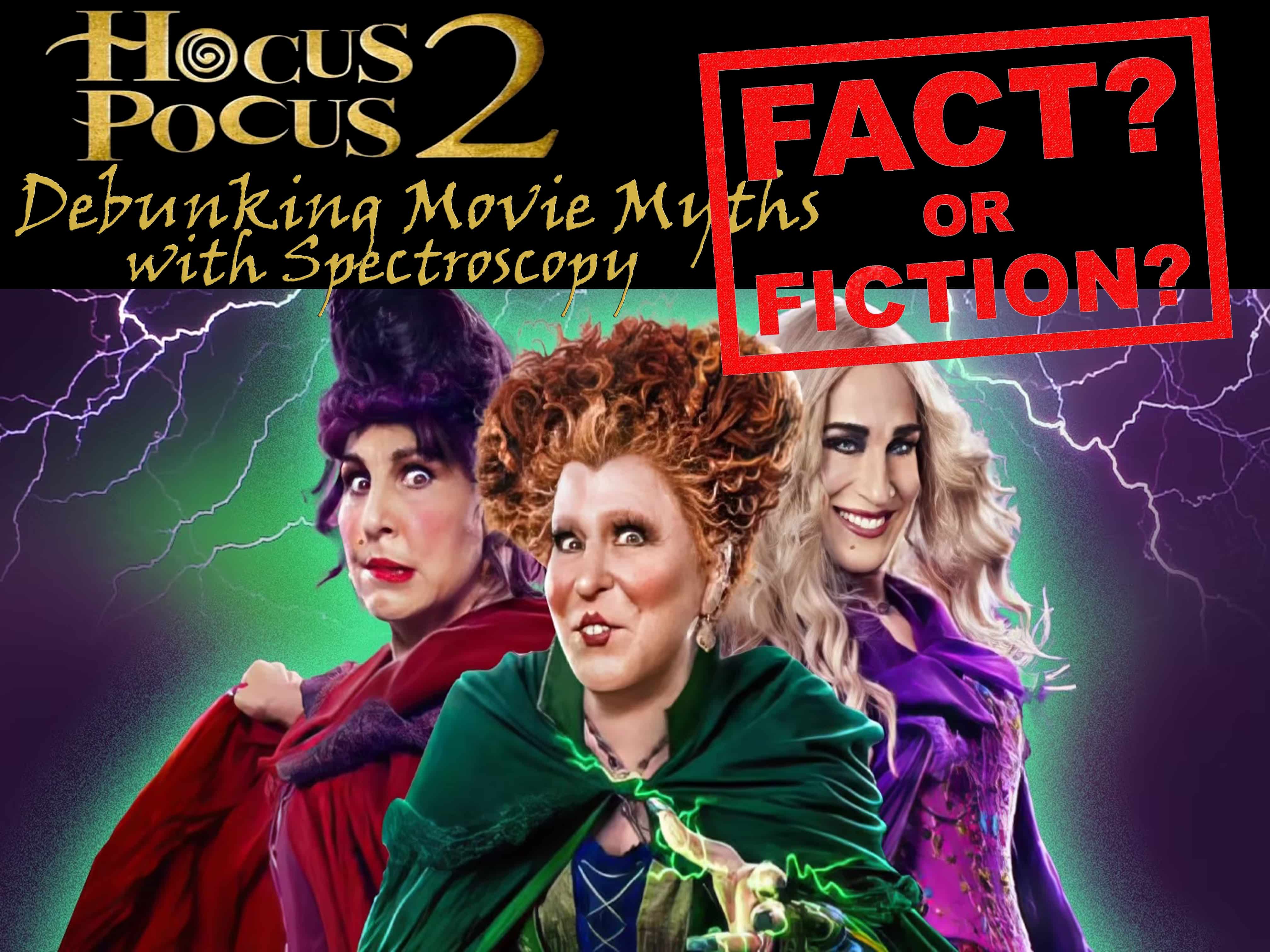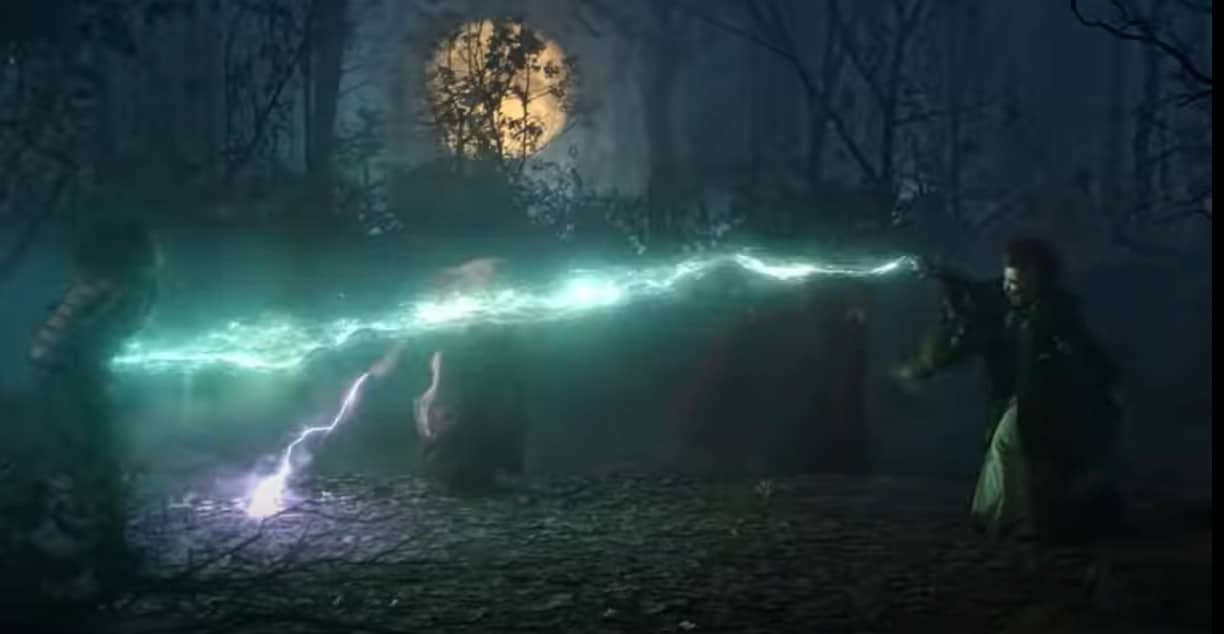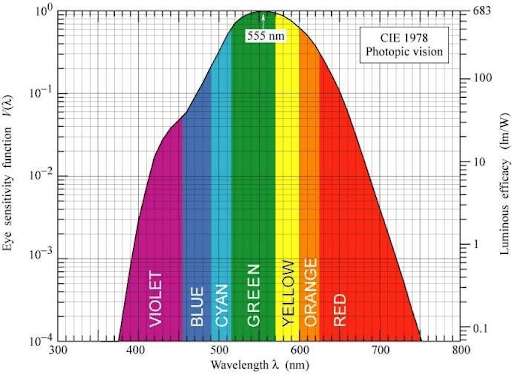
Credits: Disney+ Hotstar
The StellarNet coven is back and ready to help you gain intelligence from light! Last year, our witches and warlocks used a variety of spectroscopy techniques to further their knowledge and gain more power over light. This year, they are using their wicked skills to bust some popular myths brought by an exciting sequel to a much beloved movie. Please enjoy this year’s Halloween Spectroscopy Series.
Warning: This article contains spoilers for Hocus Pocus 2
Myth #1: The Sanderson Sisters’ new Light-zapping Abilities are Reflective of their Power

Shorter wavelengths actually have higher amounts of energy than longer wavelengths. So, if the amount of power of the lightning zaps was based on the color/wavelength of the zap, then Sarah’s purple zap would actually have been the most powerful because it is the shortest wavelength, followed by Winifred’s green zap, and then Mary’s orange zap.
If Winifred’s wasn’t the strongest then why was it the brightest?



This is another common misconception and it is because green light of the same power appears to be brighter than the other colors because humans can actually see green light the best! This is because of the natural color sensitivity of the human eye. The photopic response curve to the right shows our eyes’ response to light as a function of color. However, it is not indicative that it has the most energy. A great example of this is in lighting design with RGB LED colors, the green power intensity is often reduced to match the output photopically to other colors!
Myth #2: Do beauty products such as lotions and creams actually contain children’s souls?
They say beauty is in the eye of the beholder, but what if you’ve just been summoned after years of being banished to another realm to retake your powers? Instead of attempting a very complicated potion, is there another way to ingest youthfulness? Could cosmetics & beauty products hold the key? In Hocus Pocus 2, the Sanderson witches entered a modern day Walgreens and were convinced lotions (sounding like “potions”) contained children’s souls. And even that a beauty mask was the face of a child!

Well, we all know that little girls are made of sugar and spice and everything nice while boys are made of snips of snails and puppy dog tails. StellarNet offers many analytical techniques to identify unknowns. Two of the most popular options is Raman spectroscopy and NIR spectroscopy. The StellarNet witches took some popular beauty products and tested the concoctions for sugar, spice, snails, and puppy dog tails. Using SpectraWiz’s Raman-ID function, the witches took samples of their known items and compared the spectra to that of the beauty products.


Unfortunately, the Stellar coven is marking this myth as false, we can see from the data above that there was not a Raman spectral match for children’s souls found in sample lotions we purchased from our local Walgreens. To compare, last year our Stellar witches used handheld Raman to differentiate Unicorn and Dragon Horn. Watch the Raman DEMO. It appears we won’t be able to ingest youthfulness from beauty products alone – maybe that is why they all say for external use only 🙂
*Note : no snails or puppy dog tails were actually used
Myth #3 : Can Salt Protect Against Black Magic?
StellarNet Has The Solution! Typically employed by sinister witches and wizards for evil and selfish purposes, black magic is a force to be reckoned with. It is used by the Sanderson Sisters in Hocus Pocus 2. One cannot be too careful, so StellarNet has come up with some reliable solutions to protect you from any ne’er-do-wells aspiring to turn black magic against you and your family. Knowledge is power – don’t leave home without protection this Halloween season.
A popular trope in spooky tales is to use a ring of salt poured out onto the floor as a barrier against dark magic. As it turns out, this practice is grounded in spectroscopic techniques. A common practice to characterize our spectroscopic instruments is to use salt solutions as a means to quantify stray light in any optical setup. These salts are dissolved into water at specific ratios to block light from passing to the detector. This is a predictable phenomenon and very helpful in determining levels of unwanted stray light.
What is stray light?
Stray light is an unwanted light signal detected in the spectrometer at regions where there should be no light present. Stray light scatter can occur in any optical system, and on some level, every optical system has some level of stray light. Typical sources of stray light could be: having too many optical components, misalignment of components, poor optical design, unclean surfaces of optics, haze or imperfections in optics, aberrations in optical components, scattering of light from optical components and light leaks in the optical bench. Spectroscopists have many tricks and methods to reduce the levels of stray light – trade secrets of the light arts.
The BLACK-Comet is a novel spectrometer design because it uses a holographic concave grating to reduce stray light. Compared to traditional optical designs, like the crossed Czerny Turner optical design, which has 3 optical components between the entrance slit and the detector, the BLACK-Comet only has one, thus greatly reducing the stray light in the system and increasing sensitivity of the system to the intended order sorted light by three fold.
How can we protect ourselves from stray light?
The salt solution is prepped, then decanted into a cuvette cell and inserted into the spectrophotometer’s chamber, blocking the path of light from the source into the detector. Light below (at shorter wavelengths than) the cutoff wavelength will be completely absorbed by the salt solution and light above the cutoff passes freely. Because these solutions block the UV light, we can use them to quantify unwanted stray light in the optical system; any light detected between 180nm and the cutoff is considered stray light.
Some examples of salt compounds which can be used to block UV light:
KCl 180-200nm
NaCl 180-205nm
Li2CO3 180-227nm
KI 180-260nm
NaI 180-260nm
NaNO2 180-391nm
What does all of this have to do with dark magic?
Common knowledge dictates that UV light is black light; at StellarNet, we hypothesize that black magic is rooted in UV black-light. To combat this, we recommend that you adhere to the following guidelines when protecting yourself against the dark arts:
For the darkest of magic, we recommend a 1.2% aqueous solution of Potassium Chloride, which has a cutoff of 200nm. If you don’t have access to KCl, a 1% solution of Sodium Chloride can be used in a pinch – it blocks 180-205nm.
For broader spells of evil, a 1% aqueous solution of Potassium Iodide or Sodium Iodide are both good choices as they block 180nm to 260nm. Lithium Carbonate is a tricky one as you need to completely saturate the aqueous solution, so we only recommend it for spells casting in the 180-227nm range. A 5% aqueous solution of Sodium Nitrite is the best choice for a catch-all dark spell blocker, but it blocks all the way up to 391nm, which may get in the way of lightly offensive spells which you might want to use; if you are a bit roguish, you may not want to use this option.
The above recipes are the same solutions used for stray light analysis – keep some in your stores for stray light quantification and as a handy black magic replant.
Read Last Year’s Halloween App Series: Hocus Pocus with a Spectroscopy Focus
Many moons ago, four Stellar witches found their ancient spectroscopy knowledge waning. These particular witches had been practicing their craft for many years, using their powers to provide spectroscopy solutions and potions to their loyal StellarNet coven. Read more







